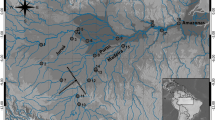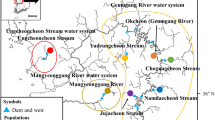Abstract
Stocking of exogenous, hatchery-reared white-spotted charr Salvelinus leucomaenis has been conducted throughout much of their range in Honshu Island, Japan, to increase angling opportunities. Although the native char populations are thought to have declined because of hybridization with introduce fish, their distribution and genetic status have been uncertain. Fine population structures of charr in the upper Tone River drainage were examined using mitochondrial DNA and microsatellite analyses so as to clarify the presence of native populations. One common mtDNA haplotype was detected in all populations in the Ohashi River and Watarase River, and four and one tributary populations were monomorphic for such haplotypes, respectively. However, several haplotypes, considered to have originated from stocked hatchery fish, were observed in the stocked and the remaining populations. Judging from the genetic integrity over a fine geographic scale, the former were considered as indicative of native populations and the latter as admixtures with hatchery fish. Comparisons of genetic diversity, deviations from the Hardy-Weinberg equilibrium, principal component analysis, and relatedness estimations based on microsatellite DNA can also provide evidence for distinguishing native populations from those influenced by hatchery fish.
Similar content being viewed by others
References
Tachikawa W, Honjo T. Stocking in rivers. In: Zenkoku koshou kasen youshoku kenkyukai (eds), Studies in Culture of Trout. Midori-shobo. Tokyo, 1976; 123–137 (in Japanese).
Waples RS. Genetic interactions between hatchery and wild Salmonids: lessons from the Pacific Northwest. Can. J. Aquat. Sci. 1991; 48 (Suppl. 1): 124–133.
Ferguson A, Taggart JB, Prodohl PA, McMeel O, Thompson C, Stone C, McGinnity P, Hynes RA. Population and conservation. J. Fish Biol. 1995; 47 (Suppl. A): 103–126.
Kato K. Masu-salmon Amago-salmon, Ecology and Fishing. Tsuribito-sha, Tokyo. 1991, (in Japanese).
Yamamoto S. Japanese Charr, Ecology and Fishing. Tsuribito-sha Tokyo. 1991. (in Japanese).
Nakamura T. An ecological role of tributaries in Japanese charr. In: Mori S (ed.). Freshwater Environment from a Viewpoint of Fish Ecology (Sakana kara mita mizu kankyo). Shinzan-Sha Sci-Teck, Tokyo 1998: 177–187 (in Japanese).
Nakamura T. Estimation of the distribution of genetically pure populations of the Japanese charr by inquiring survey. J. Jpn Soc. Erosion Control 2001: 53: 3–9.
Leary RF, Gould WR, Sage GK. Success of basibranchial teeth in indicating pure populations of rainbow trout and failure to indicate pure populations of westslope cutthroat trout. N. Am. J. Fish. Manage. 1996; 16: 210–213.
Weigel DE, Peterson JT, Spruell P. A model using phenotypic characteristics to detect introgressive hybridization in wild westslope cutthroat trout and rainbow trout. Trans. Am. Fish. Soc. 2002; 131: 389–403.
Sheehan TF, Kocik JF, Cadrin SX, Legault CM, Atkinson E, Bengtson D. Marine growth and morphometrics for three populations of Atlantic salmon from Eastern Maine. USA Trans. Am. Fish. Soc. 2005; 134: 775–788.
Takeda K, Onodera S, Yoshiyasu K. Salvelinus leucomaenis with atypical color patterns, collected in the Mogami and Nikko River systems, Yamagata Prefecture, Japan. Jpn. J. Ichthyol. 1978; 25: 58–64.
Yamamoto S, Kohara M, Sawamoto Y, Tsukisaka M. Variation of spots in Japanese char Salvelinus leucomaenis in the rivers of Nagano prefecture. Japan. Bull. Nagano Pref. Fish. Exp. Stn. 2000; 4: 16–23.
Nakamura T. Meristic and morphometric variations in fluvial Japanese charr between river systems and among tributaries of a river system. Env. Biol. Fish. 2003; 66: 133–141.
Nakajima M, Fujio Y. Genetic differentiation among local populations of Japanese char Salvelinus leucomaenis. Fish. Sci. 1995; 61: 11–15.
Yamamoto S, Morita K, Kitano S, Watanabe K, Koizumi I. Maekawa K, Takamura K, Phylogeography of white-spotted charr (Salvelinus leucomaenis) inferred from mitochondrial DNA sequences. Zool. Sci. 2004; 21: 229–240.
Williams RN, Shiozawa DK, Carter JE, Leary RF. Genetic detection of putative hybridization between native and introduced rainbow trout populations of the upper-Snake River. Trans. Am. Fish. Soc. 1996; 125: 387–401.
McCracken GF, Parker CR, Guffey SZ. Genetic differentiation and hybridization between stocked hatchery and native brook trout in Great Smoky Mountains National Park. Trans. Am. Fish. Soc. 1993; 122: 533–542.
Araguas RM, Sanz N, Pla C, Garcia-Marin JL. Breakdown of the brown trout evolutionary history due to hybridization between native and cultivated fish. J. Fish Biol. 2004; 65 (Suppl. A): 28–37.
Piller KR, Wilson CC, Lee CE, Lyons J. Conservation genetics of inland lake trout in the upper Mississippi River basin: stocked or native ancestry? Trans. Am. Fish. Soc. 2005; 134: 789–802.
Inoue JG, Miya M, Tsukamoto K, Nishida M. Complete mitochondrial DNA sequence of the Japanese sardine Sardinops melanostictus. Fish. Sci. 2000; 66: 924–932.
Aoyama J, Watanabe S, Ishikawa S, Nishida M, Tsukamoto K. Are morphological characters distinctive enough to discriminate between two species of freshwater eels, Anguilla celebesensis and A. Interior. Ichthyol. Res. 2000; 47; 157–161.
Angers B, Bernatchez L, Angers A, Desgroseillers L. Specific microsatellite loci for brook charr reveal strong population subdivision on a microgeographic scale. J. Fish Biol. 1995; 47 (Suppl. A): 177–185.
Sakamoto T, Okamoto N, Ikeda Y. Dinucleotide repeat polymorphism of rainbow trout, FGT3. J. Anim. Sci. 1994; 72: 2766–2767.
Small MP, Beacham TD, Withler RE, Nelson RJ. Discriminating coho salmon (Oncorhynchus kisutch) populations within the Fraser River, British Columbia, using microsatellite DNA markers. Mol. Ecol. 1998; 7: 141–155.
O’Reilly PT, Hamilton LC, McConnell SK, Wright JM. Rapid analysis of genetic variation in Atlantic salmon (Salmo salar) by PCR multiplexing of dinucleotide and tetranucleotide microsatellites. Can. J. Fish. Aquat. Sci. 1996; 53: 2292–2298.
Estoup A, Rousset F, Michalakis Y, Cornuet JM, Adriamanga M, Guyomard R. Comparative analysis of microsatellite and allozyme markers: a case study investigating microgeographic differentiation in brown trout (Salmo trutta). Mol. Ecol. 1998; 7: 339–353.
Schneider S, Roessili D, Excoffier L. ARLEQUIN: A Software for Population Genetics Data Analysis, Ver 2.001. Genetics and Biometry Laboratory, Department of Anthropology, University of Geneva. Geneva. 2001. Available from URL: http://lgb.unige. ch/arlequin/
Raymond M, Rousset F. GENEPOP ver. 3.4: population genetics software for exact tests and ecumenicism. J. Hered. 1995; 86: 248–249.
Rice WR. Analyzing tables of statistical tests. Evolution 1989; 43: 223–225.
Gouded J. PCA-GEN Ver. 1. 2. Population Genetics Laboratory. University of Lausanne. Lausanne. 1999. Available from URL: http://www.unil.ch/izea/softwares/peagen. html.
Queller DC, Goodnight KF. Estimating relatedness using genetic markers. Evolution 1989; 43: 258–275.
Cavalli-Sforza LL, Edwards AWF. Phylogenetic analysis: models and estimation procedures. Am. J. Human Genet 1967; 19: 233–257.
Minch E, Ruiz-Linares A, Goldstein D, Feldman M, Cavalli-Sforza LL. Microsat (Ver. 1.5): A Computer Program for Calculating Various Statistics on Microsatellite Allele Data. Stanford University Medical Center, Stanford, CA 1996. Available from URL: http://hpgl.staford.edu/projects/microsat/microsat.html
Felsenstein J. PHYLIP (Phylogeny Inference Package) Ver. 3.6b. Department of Genome Science, University of Washington, Seattle, WA. 2004. Available from URL: http://evolution.gs.washington.edu/phylip.html.
Tessier N, Bernatchez L, Wright M. Population structure and impact of supportive breeding inferred from mitochondrial and microsatellite DNA analysis in land-locked Atlantic salmon Salmo salar L. Mol. Ecol. 1997; 6: 735–750.
Brunner PC, Douglas MR, Bernatchez L. Microsatellite and mitochondrial DNA assessment of population structure and stocking effects in Arctic charr Salvelinus alpinus (Teleostei: Salmonidae) from central Alpine lakes. Mol. Ecol. 1998; 7: 209–223.
Kanda N, Allendorf FW. Genetic population structure of bull trout from the Flathead River basin as shown by microsatellite and mitochondrial DNA markers. Trans. Am. Fish. Soc. 2001; 130: 92–106.
Spruell P, Hemmingsen AR, Howell PJ, Kanda N, Allendorf FW. Conservation genetics of bull trout: geographic distribution of variation at microsatellite loci. Conserv. Genet 2003; 4: 17–29.
Matsuura S. Development of the National Land and Rivers in Japan. Kashima-Shuppankai, Tokyo. 1989 (in Japanese).
Birky CW, Maruyama T, Fuerst P. An approach to population and evolutionary genetic theory for genes in mitochondria and chloroplasts, and some results. Genetics 1983; 103: 513–527.
Nei M. Molecular Evolutionary Genetics. Columbia University Press. NY. 1987.
Yamamoto S, Morita K, Koizumi I, Maekawa K. Genetic differentiation of white-spotted charr (Salvelinus leucomaenis) populations after habitat fragmentation: spatialtemporal changes in gene frequencies. Conserv. Genet. 2004; 5: 529–538.
Marzano FN, Corradi N, Papa R, Tagliavini J, Gandolfi G. Molecular evidence for introgression and loss of genetic variability in Salmo (trutta) macrostigma as a result of massive restocking of Apennine populations (Northern and Central Italy). Environ. Biol. Fish. 2003; 68: 349–356.
Kanda N, Leary RF, Allendorf FW. Population genetic structure of bull trout in the upper Flathead River drainage. In: Mackay WC, Brewin MK, Monita M (eds). Friends of the Bull Trout Conference Proceedings. Bull Trout Task Force (Alberta), Trout Unlimited Canada, Calgary, AB. 1997; 299–308.
Costello AB, Down TE, Pollard SM, Pacas CJ, Taylor FB. The influence of history and contemporary stream hydrology on the evolution of genetic diversity within species: an examination of microsatellite DNA variation in bull trout, Salvelinus confluentus (Pisces: Salmondae). Evolution 2003; 57: 328–344.
Van Houdt JKJ Pinceel J, Flamand M-C, Briquet M, Dupont E, Volckaert FAM, Baret PV. Migration barriers protect indigenous brown trout (Salmo trutta) populations from introgression with stocked hatchery fish. Conserv. Genet. 2005; 6: 175–191.
Sekino M, Sugaya T, Hara M, Taniguchi N. Relatedness inferred from microsatellite genotypes as a tool for broodstock management of Japanese flounder Paralichthys olivaceus. Aquaculture 2004; 233 163–172.
Ditlecadet D, Dufresne F, Le François NR, Blier PU. Applying microsatellites in two commercial strains of Arctic charr (Salvelinus alpinus): potential for a selective breeding program. Aquaculture 2006; 257: 37–43.
Allendorf FW, Phelps SR. Loss of genetic variation in a hatchery stock of cutthroat trout. Trans. Am. Fish. Soc. 1980; 109: 537–543.
Allendorf FW, Ryman N. Genetic management of hatchery stocks. In: Ryman N, Utter FW (eds). Population Genetics and Fishery Management. Washington sea grant program. University of Washington Press. Seattle, WA. 1987; 141–159.
Ståhl G. Differences in the amount and distribution of genetic variation between natural populations and hatchery stocks of Atlantic salmon. Aquaculture 1983; 33: 23–32.
Maekawa K, Koseki Y, Iguchi K, Kitano S. Skewed reproductive success among male white-spotted charr land-locked by an erosion control dam: implications for effective population size. Ecol. Res. 2001; 16: 727–735.
Harig AL, Fausch KD, Young MK. Factors influencing success of greenback cutthroat trout translocations. N. Am. J. Fish. Manage. 2000; 20: 994–1004.
Hilderbrand RH, Kershner JL. Conserving inland cutthroat trout in small streams: how much stream is enough? N Am. J. Fish. Manage. 2000; 20: 513–520.
Novinger DC, Rahel FJ. Isolation management with artificial barriers as a conservation strategy for cutthroat trout in headwater streams. Conserv. Biol. 2003; 17: 772–781.
Morita K, Yamamoto S. Effects of habitat fragmentation by damming on the persistence of stream-dwelling charr populations. Conserv. Biol. 2002; 16: 1318–1323.
Author information
Authors and Affiliations
Corresponding author
Rights and permissions
About this article
Cite this article
Kubota, H., Doi, T., Yamamoto, S. et al. Genetic identification of native populations of fluvial white-spotted charr Salvelinus leucomaenis in the upper Tone River drainage. Fish Sci 73, 270–284 (2007). https://doi.org/10.1111/j.1444-2906.2007.01333.x
Received:
Accepted:
Issue Date:
DOI: https://doi.org/10.1111/j.1444-2906.2007.01333.x




